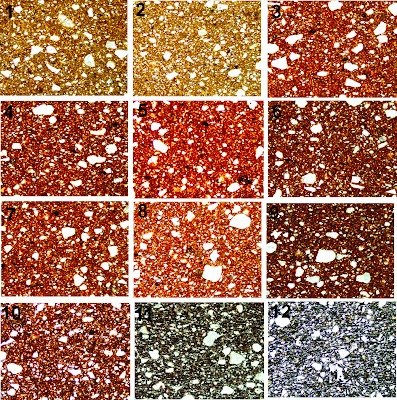Skip to main content
Micrograph of the Month: Fabulous Fired Clay
 Here is a nice series of micrographs from a little experiment I did many years ago, back when I was a research assistant at the University of Reading, shortly after finishing my PhD. Professor John Allen had collected a clay sample associated with the Roman town of Silchester, and conducted a series of firing sessions in a kiln, each in increments of 100°C, to provide a collection of reference slides for fired clays in thin section. As I had been working on infra red spectroscopy at the time, I used the same fired samples to produce a series of reference FT-IR spectra to compare with the micrographs. We presented this as a poster at the 5th Experimental Archaeology conference in Reading 2011, though I never really took the work further, as I became more interested in developing the use of organic geochemical techniques rather than inorganic. FT-IR is a great technique for certain materials, but archaeological samples tend to be so mixed and hetergeneous it can be hard to get definitive data with FT-IR. The raw clay was heated from 100 to 1200°C. Distinct colour changes and alterations in the fine fabric can be seen in thin section around 300°C, 500°C, 900°C and 1100°C, coresponding with structural changes in the clay as it becomes more crystalline.
Here is a nice series of micrographs from a little experiment I did many years ago, back when I was a research assistant at the University of Reading, shortly after finishing my PhD. Professor John Allen had collected a clay sample associated with the Roman town of Silchester, and conducted a series of firing sessions in a kiln, each in increments of 100°C, to provide a collection of reference slides for fired clays in thin section. As I had been working on infra red spectroscopy at the time, I used the same fired samples to produce a series of reference FT-IR spectra to compare with the micrographs. We presented this as a poster at the 5th Experimental Archaeology conference in Reading 2011, though I never really took the work further, as I became more interested in developing the use of organic geochemical techniques rather than inorganic. FT-IR is a great technique for certain materials, but archaeological samples tend to be so mixed and hetergeneous it can be hard to get definitive data with FT-IR. The raw clay was heated from 100 to 1200°C. Distinct colour changes and alterations in the fine fabric can be seen in thin section around 300°C, 500°C, 900°C and 1100°C, coresponding with structural changes in the clay as it becomes more crystalline.
 Here is a nice series of micrographs from a little experiment I did many years ago, back when I was a research assistant at the University of Reading, shortly after finishing my PhD. Professor John Allen had collected a clay sample associated with the Roman town of Silchester, and conducted a series of firing sessions in a kiln, each in increments of 100°C, to provide a collection of reference slides for fired clays in thin section. As I had been working on infra red spectroscopy at the time, I used the same fired samples to produce a series of reference FT-IR spectra to compare with the micrographs. We presented this as a poster at the 5th Experimental Archaeology conference in Reading 2011, though I never really took the work further, as I became more interested in developing the use of organic geochemical techniques rather than inorganic. FT-IR is a great technique for certain materials, but archaeological samples tend to be so mixed and hetergeneous it can be hard to get definitive data with FT-IR. The raw clay was heated from 100 to 1200°C. Distinct colour changes and alterations in the fine fabric can be seen in thin section around 300°C, 500°C, 900°C and 1100°C, coresponding with structural changes in the clay as it becomes more crystalline.
Here is a nice series of micrographs from a little experiment I did many years ago, back when I was a research assistant at the University of Reading, shortly after finishing my PhD. Professor John Allen had collected a clay sample associated with the Roman town of Silchester, and conducted a series of firing sessions in a kiln, each in increments of 100°C, to provide a collection of reference slides for fired clays in thin section. As I had been working on infra red spectroscopy at the time, I used the same fired samples to produce a series of reference FT-IR spectra to compare with the micrographs. We presented this as a poster at the 5th Experimental Archaeology conference in Reading 2011, though I never really took the work further, as I became more interested in developing the use of organic geochemical techniques rather than inorganic. FT-IR is a great technique for certain materials, but archaeological samples tend to be so mixed and hetergeneous it can be hard to get definitive data with FT-IR. The raw clay was heated from 100 to 1200°C. Distinct colour changes and alterations in the fine fabric can be seen in thin section around 300°C, 500°C, 900°C and 1100°C, coresponding with structural changes in the clay as it becomes more crystalline. 
Comments
Post a Comment